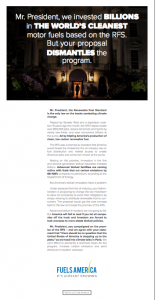 In honor of its successful photo campaign featuring the people of the ethanol industry, the American Coalition for Ethanol awarded its first “Power by People” award at last week’s annual meeting.
In honor of its successful photo campaign featuring the people of the ethanol industry, the American Coalition for Ethanol awarded its first “Power by People” award at last week’s annual meeting.
The award was presented to Husker Ag of Plainview, Nebraska for the plant’s continued efforts to provide consumers access to higher ethanol blends. The new award was created to recognize a plant or an individual who has gone the extra mile to help get ethanol’s message out to the public.
“Everyone is very proud to have worked together to receive this prestigious award,” said Seth Harder, Husker Ag general manager. “We are proud to be members of Husker Ag.”
ACE Executive Director Brian Jennings said Husker Ag’s recent response to a Renewable Fuels Standard (RFS) public hearing made them a perfect fit for the inaugural Power by People Award. According to Jennings, when the RFS hearing was announced, Harder and his team immediately stepped forward with a group of employees, shareholders, investors and a fuel retailer to testify in Kansas City despite short notice.
In addition to addressing policy issues, Husker Ag provides support for flex fuel infrastructure throughout northeast Nebraska. In 2012, Husker Ag passed a resolution to promote higher ethanol fuel blends at the retail level. Since then, the Plainview ethanol plant has provided grant money and ethanol for several retail locations including Creighton, Crofton, Hartington, Osmond, and Pierce at two locations. Plainview and Norfolk locations are in various stages of flex fuel pump installation, and equipment is ready for installation at possibly four more locations.











